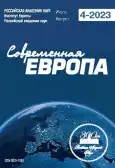Migration policy in Albania: institutional aspects
- 作者: Gorokhov S.A.1, Dmitriev R.V.1
-
隶属关系:
- Institute for African Studies Russian Academy of Sciences
- 期: 编号 4 (118) (2023)
- 页面: 77-88
- 栏目: Articles
- URL: https://journals.rcsi.science/0201-7083/article/view/142212
- DOI: https://doi.org/10.31857/S0201708323040034
- EDN: https://elibrary.ru/BVWBOC
- ID: 142212
如何引用文章
全文:
详细
作者简介
Stanislav Gorokhov
Institute for African Studies Russian Academy of Sciences
Email: stgorohov@yandex.ru
Moscow, Russia
Ruslan Dmitriev
Institute for African Studies Russian Academy of Sciences
Email: dmitrievrv@yandex.ru
Moscow, Russia
参考
- Абрамова И.О. (2016) Мусульманские диаспоры Евросоюза в гендерном, генерационном и пространственном измерениях. От демографии к социальной антропологии. Ученые записки Института Африки РАН. № 1 (35). С. 25-32.
- Абрамова И.О., Бессонов С.А. (2012) "Арабская весна" и трансграничная миграция. Азия и Африка сегодня. № 7 (660). С. 10-15.
- Дегтерев Д.А., Ковалева Д.В. (2016) Роль Албании и албанской организованной преступности в транзите наркотиков по "балканскому маршруту": сетевой анализ. Национальная безопасность / Nota Bene. № 4 (45). С. 509-518. DOI: https://doi.org/10.7256/2073-8560.2016.4.19364
- Дрыночкин А.В. (2016) Трансформация в Албании: медленно, но верно? Переход стран Центрально-Восточной Европы от социализма к капитализму: особенности и результаты. Под ред. С.П. Глинкиной, Н.В. Куликовой. Институт экономики РАН, Москва. С. 12-43.
- Зеликсон Д.И. (2016) Экономическая дипломатия Греции в Албании: от политического влияния до экономических выгод. Большое Причерноморье: противоречия и стратегические решения для России. Под ред. А.А. Язьковой. Институт Европы РАН, Москва. С. 76-81.
- Кандель П.Е. (2021) Албанский вопрос сегодня. Научно-аналитический вестник ИЕ РАН. № 3 (21). С. 77-83. DOI: https://doi.org/10.15211/vestnikieran320217783
- Кокомани А.Б. (2016) Внешнеэкономические связи современной Албании: экономическая дипломатия. МАКС Пресс, Москва. 164 с.
- Пономарева Е.Г. (2018) Албанский фактор дестабилизации Западных Балкан: сценарный подход. Вестник МГИМО-Университета. № 2 (59). С. 99-124. DOI: https://doi.org/10.24833/2071-8160-2018-2-59-99-124
- Растегаев Д. (2021) Балканский ветер перемен: последствия размещения беженцев из Афганистана в Албании, Косово и Северной Македонии. Европейская безопасность: события, оценки, прогнозы. № 63 (79). С. 29-35.
- Смирнова Н.Д. (2003) История Албании в XX веке. Наука, Москва. 431 с.
- Энтина Е.Г., Синопальников Н.С. (2020) Фактор арабо-мусульманского мира в развитии стран бывшей Югославии и Албании. Современная Европа. № 2 (95). С. 131-142. DOI: https://doi.org/10.15211/soveurope22020131142
- Agafoshin M.M., Gorokhov S.A., Dmitriev R.V. (2022) Refugees from Syria and Iraq in Sweden: Resettlement During the Migration Crisis. Baltic Region. Vol. 14. No. 4. P. 98-112. DOI: https://doi.org/10.5922/2079-8555-2022-4-6
- Gëdeshi I., King R. (2018) New Trends in Potential Migration from Albania. Friedrich-Ebert-Stiftung, Tirana, Albania. 86 p.
- Londo E. (2009) Modernization Project Helps Improve Public Services in Albania. OSCE. 06.02. URL: https://www.osce.org/albania/57717
- Oruc N., Raza S., Santic D. (2020) The Western Balkan Migration Route (2015-2019): Analytical Report. Prague Process Secretariat International Centre for Migration Policy Development (ICMPD), Vienna, Austria. URL: https://www.pragueprocess.eu/en/migration-observatory/publications/33-reports/289-the-western-balkan-migration-route-2015-2019 (accessed: 29.03.2023).
- Xhaho A., Lleshi Tandili A. (2019) Vulnerable Asylum Seekers and Irregular Migrants in Albania: Trends, Challenges, and Policy Solutions. The Institute for Democracy and Mediation. June. URL: https://idmalbania.org/wp-content/uploads/2021/11/policy-brief_Vulnerable-asylum-seekers-and-irregulat-migrants-1.pdf (accessed: 24.03.2023).
补充文件









